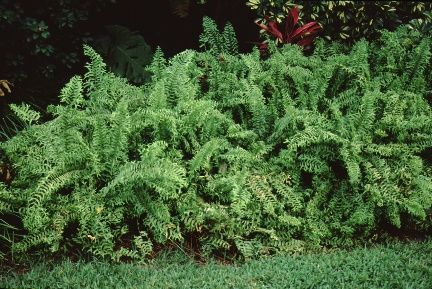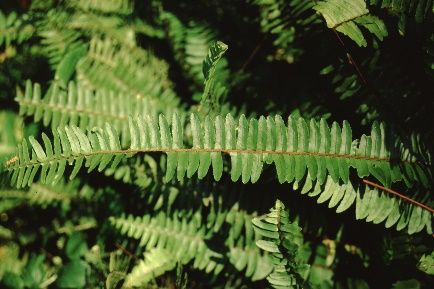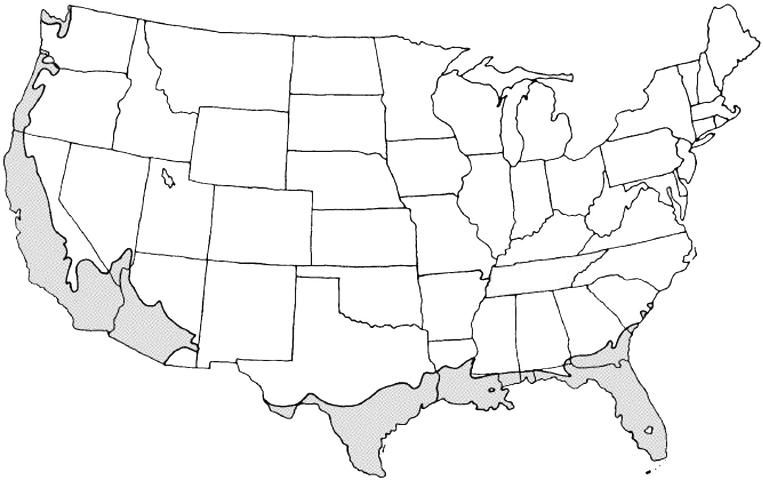Introduction
This dependable, easy-to-grow fern produces great masses of long, narrow, pale green leaves, creating beautiful hanging baskets or gently arching out of raised containers. But sword fern also makes a wonderful ground cover, creating a dense, tropical effect, its 2 to 3 foot high, graceful fronds quickly spreading over the ground by means of thin, green runners. While somewhat invasive in ideal locations, sword fern can be controlled by thinning, the removed plants will transplant extremely well. It may be best to confine a grouping of plants with an edging such as plastic or metal to prevent spreading into unwanted areas.

Credit: Edward F. Gilman, UF/IFAS

Credit: Edward F. Gilman, UF/IFAS
General Information
Scientific name: Nephrolepis exaltata
Pronunciation: neff-FRAHL-lepp-piss eck-sahl-TAY-tuh
Common name(s): Boston fern, sword fern, wild Boston fern
Family: Davalliaceae
Plant type: perennial; herbaceous
USDA hardiness zones: 8B through 11 (Figure 3)
Planting month for zone 8: year-round
Planting month for zone 9: year-round
Planting month for zone 10 and 11: year-round
Origin: native to North America
Invasive potential: potentially invasive
Uses: mass planting; container or above-ground planter; naturalizing; hanging basket; suitable for growing indoors
Availability: generally available in many areas within its hardiness range

Credit:
Description
Height: 0.5 to 4 feet
Spread: depends upon supporting structure
Plant habit: upright
Plant density: moderate
Growth rate: fast
Texture: fine
Foliage
Leaf arrangement: most emerge from the soil, usually without a stem
Leaf type: even-pinnately compound
Leaf margin: serrate; undulate
Leaf shape: lanceolate; ovate
Leaf venation: none, or difficult to see
Leaf type and persistence: semi-evergreen
Leaf blade length: 2 to 4 inches
Leaf color: green
Fall color: no fall color change
Fall characteristic: not showy
Flower
Flower color: no flowers
Flower characteristic: no flowers
Fruit
Fruit shape: no fruit
Fruit length: no fruit
Fruit cover: no fruit
Fruit color: no fruit
Fruit characteristic: no fruit
Trunk and Branches
Trunk/bark/branches: not applicable
Current year stem/twig color: not applicable
Current year stem/twig thickness: not applicable
Culture
Light requirement: plant grows in part shade/part sun; plant grows in the shade
Soil tolerances: occasionally wet; clay; sand; acidic; slightly alkaline; loam
Drought tolerance: moderate
Soil salt tolerances: poor
Plant spacing: 24 to 36 inches
Other
Roots: not applicable
Winter interest: no special winter interest
Outstanding plant: not particularly outstanding
Pest resistance: long-term health usually not affected by pests
Use and Management
Growing in partial to deep shade, sword fern needs moist but well-drained soils until established but can later survive periodic bouts of dry weather. Light fertilizations are recommended during the growing season. Thick clumps can be stimulated by severe pruning, new fronds quickly sprouting from the roots. Plant on 12 to 24 inch centers for quick establishment.
Many cultivars are available for leaf structure, height and growth rate. 'Bostoniensis' is the classic indoor fern, with a spreading and arching growth habit; 'Fluffy Ruffles', 'Rooseveltii', and 'Whitmanii' all have more finely cut and feathery fronds.
Propagation is easily done by division of the clumps.
Pests and Diseases
Sword fern may at times be bothered by scale, mites, mealy bugs, snails, or slugs.
Fungal diseases may occasionally be a problem.